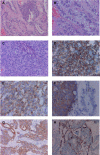An Ovarian Large-Cell Neuroendocrine Carcinoma Accompanied by Clear Cell Carcinoma with Specific High Level of AFP: Case Report and Review of the Literature
- PMID: 35909650
- PMCID: PMC9326035
- DOI: 10.2147/CMAR.S366771
An Ovarian Large-Cell Neuroendocrine Carcinoma Accompanied by Clear Cell Carcinoma with Specific High Level of AFP: Case Report and Review of the Literature
Abstract
Large cell neuroendocrine carcinoma (LCNEC) is a rare histological subtype of ovarian cancer. A few cases have been reported in the literature with extreme invasiveness and a poor prognosis. However, there still have not been accepted criteria for diagnosis and treatment of LCNEC. Here we report an unmarried 37 year-old woman who was diagnosed with LCNEC associated with clear cell carcinoma and the tumor index was manifested with a specific increase of AFP. The case received six courses of etoposide and carboplatin chemotherapy as an adjuvant therapy after primary curative surgery. However, she relapsed within 6 months after surgery and metastasized rapidly to distant organs despite combined chemotherapy of paclitaxel, cisplatin, and bevacizumab, and died 18 months after primary surgery. This is the first reported case of LCNEC manifested with a specific increase of AFP and characteristically metastasized to the spine as recurrence. Reviewing our case as well as previously reported cases, LCNEC present with aggressive malignancy and vulnerable to distant metastasis through a hematogenous approach, we conjectured that adding Bevacizumab in primary chemotherapy may be beneficial to extend disease-free survival. But so far there is no recommendation of this regimen for treatment of LCNEC in current guidelines. Further research is needed to confirm this view so as to find the best treatment of LCNEC and improve the prognosis of these patients.
Keywords: large cell neuroendocrine carcinoma; ovarian tumors.
© 2022 Qiu et al.
Conflict of interest statement
The authors declare that they have no conflicts of interest in relation to this work.
Figures





Similar articles
-
Pathological features, clinical presentations and prognostic factors of ovarian large cell neuroendocrine carcinoma: a case report and review of published literature.J Ovarian Res. 2019 Jul 25;12(1):69. doi: 10.1186/s13048-019-0543-z. J Ovarian Res. 2019. PMID: 31345245 Free PMC article. Review.
-
Primary pure large cell neuroendocrine carcinoma of the ovary: A rare case report and review of literature.Medicine (Baltimore). 2020 Dec 4;99(49):e22474. doi: 10.1097/MD.0000000000022474. Medicine (Baltimore). 2020. PMID: 33285672 Free PMC article.
-
Poor prognosis of ovarian cancer with large cell neuroendocrine carcinoma: case report and review of published works.J Obstet Gynaecol Res. 2014 Mar;40(3):869-72. doi: 10.1111/jog.12235. J Obstet Gynaecol Res. 2014. PMID: 24738132 Review.
-
Combined large cell neuroendocrine carcinoma, lung adenocarcinoma, and squamous cell carcinoma: a case report and review of the literature.J Cardiothorac Surg. 2023 Aug 31;18(1):254. doi: 10.1186/s13019-023-02349-4. J Cardiothorac Surg. 2023. PMID: 37653509 Free PMC article. Review.
-
Report of two cases of large cell neuroendocrine carcinoma of duodenal ampulla with contrasting outcomes following pancreaticoduodenectomy according to the use of adjuvant chemotherapy.Int J Surg Case Rep. 2017;31:132-138. doi: 10.1016/j.ijscr.2017.01.031. Epub 2017 Jan 17. Int J Surg Case Rep. 2017. PMID: 28160741 Free PMC article.
Cited by
-
A case of alpha-fetoprotein-positive thymic small cell carcinoma: a case report.Surg Case Rep. 2023 Sep 18;9(1):165. doi: 10.1186/s40792-023-01750-4. Surg Case Rep. 2023. PMID: 37721573 Free PMC article.
-
Clinicopathologic feature and treatment progress of high-grade ovarian neuroendocrine tumors.Med Oncol. 2024 Nov 14;42(1):2. doi: 10.1007/s12032-024-02544-w. Med Oncol. 2024. PMID: 39541042 Review.
-
EYA4 drives breast cancer progression and metastasis through its novel role in replication stress avoidance.Res Sq [Preprint]. 2023 May 15:rs.3.rs-2917471. doi: 10.21203/rs.3.rs-2917471/v1. Res Sq. 2023. Update in: Mol Cancer. 2023 Sep 30;22(1):158. doi: 10.1186/s12943-023-01861-4. PMID: 37292941 Free PMC article. Updated. Preprint.
-
EYA4 promotes breast cancer progression and metastasis through its role in replication stress avoidance.Mol Cancer. 2023 Sep 30;22(1):158. doi: 10.1186/s12943-023-01861-4. Mol Cancer. 2023. PMID: 37777742 Free PMC article.
References
-
- Hirasawa T. Ovarian neuroendocrine carcinoma associated with mucinous carcinoma and teratoma. Nihon Rinsho. 2004;62(5):973–978. - PubMed
Publication types
LinkOut - more resources
Full Text Sources

